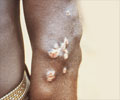A study has thrown light on the observation that multiple infectious disease strains can coexist.
A study has thrown light on the observation that multiple infectious disease strains can coexist. This has been explained in the August issue of The American Naturalist, where Ken Eames and Matt Keeling (University of Warwick) have demonstrated with the help of a mathematical model, the coexistence of multiple strains of infectious diseases and their behavior and response to human interaction, which is abetted by monogamous behavior in the population.
"When people are serially monogamous (that is, interactions take place one at a time), groups with different behavior favor strains with different properties," explain the authors. "When new interactions occur frequently, rapidly transmitted strains are most successful, but when new interactions take place infrequently there is extra pressure on strains to have a long infectious period."Eames and Keeling focused their study on sexually transmitted infections, where the assumption of monogamy is most applicable, but stress that their conclusions may have wider relevance.
"There are implications for all sorts of other infections too," Eames continues. "Just think of the behavioral differences between village and city life: one with quiet streets and few new faces, and the other with thousands of hurrying people and crowded public transport. That's two very different environments for a pathogen. There are always going to be plenty of factors that determine which strains emerge, but human mixing behavior has a big part to play."
Source : Eureka Alert











